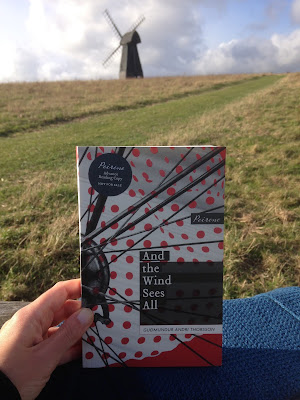In conversation with... Björg Arnadottir and Andrew Cauthery
Hi Björg and
Andrew! Thank you for joining me today. I have just finished reading And the
Wind Sees All, which you translated from the Icelandic to English, and I’d like
to ask you a few questions both on this specific book and more generally on
translation. So let’s begin…
How did you get started in literary translation?
Björg: Ever since I moved to England around forty years ago, I have always done some translation. I can’t really remember how it all started, but the fact is that not many people speak Icelandic and there are times when people need translators. There certainly were not many of these about when I first came here, and I was often asked to do translations – I guess that’s how it all started. I have always been a linguist and so it kind of evolved naturally. In the early years I translated quite a few children’s books into Icelandic, my favourite one was The Wind in the Willows, which I translated and read for the Icelandic radio. Through my contacts among Icelandic publishers I started getting asked to translate promotional sample chapters of Icelandic literature; when translating into English I always consulted Andrew and asked him to read the final draft so although it was mainly me doing the translating, he was often involved.
Andrew: Then, around the time I retired from my full-time job as an orchestral musician, we heard that Amazon Crossing were looking for Icelandic to English translators. We submitted some of the sample chapters we had done, and as a result did three crime novels for them. Things kind of snowballed after that. I’m sure our backgrounds – Björg in theatre, me in music – help. Simply speaking one’s lines correctly or playing all the right notes gets you nowhere; you have to inhabit the material you’re working with, interpret it, and I think the same applies to translating.
Did you already know the work of Gudmundur Andri Thorsson when you were approached with this translation project?
Apart from his regular newspaper column, our first encounter was when we did a couple of sample chapters of this book for his Icelandic publishers. We instantly fell in love with it, so we were thrilled when Meike asked us to do the full translation.
Can you describe the process of translating this evocative piece of literature? Do you always co-translate books?
We work as a team; B starts and A follows a day or so behind, editing and polishing. We work in separate rooms - on different floors actually, occasionally communicating on the phone, and every now and then sit down together over lunch to discuss some particular passage that one or other of us isn’t happy about. Working like this means that, whichever the direction of translation, the final read is always by the one whose mother tongue it is. And, however well you think you know the source language, there are always figures of speech or quirky phrases that it’s good to have a native speaker at hand to ask. Can be awkward, though. While subtitling Family Guy, B once embarrassed one of our teenaged sons, fresh home from school, by asking him: “What does ‘fisting’ mean?”
Did you have any contact with the author? In general, how do you find that having access to the author impacts on the translating process?
We always make contact at the beginning, and if any questions arise during the process, we email the author to ask for clarification, and when we’ve completed our first draft, we send it for the author to read and comment on. But because B is a native Icelandic speaker, we usually have very little cause to raise queries while working on a book. This is a huge advantage, and some of our authors have expressed great relief at not being endlessly pestered with questions! We contacted Gudmundur Andri twice while we were working on this book, with purely factual queries, and then having read the whole thing he made a handful of suggestions, most of which we followed (or adapted) in the final version.
Without giving too much away, can you please describe a scene that you loved translating or that was particularly difficult to render in English?
Björg: The book is so beautifully written that it’s very difficult to pick one scene over another. On the whole I loved the way the landscape and the little village came alive, I could hear it, see it and smell it, feel the fresh sea air scented with mingling smells of the sea and the strong summer sun and Arctic alpine flora and hear the sea gulls and the golden plover and the snipe. In fact, it simply took me to Iceland.
Interestingly, books that are well written are much easier – and enjoyable - to translate than badly written ones.
What are you working on at the moment?
We’re having a bit of a quiet period just now after two extremely busy years. Which is not a bad thing as we have a brand-new grandson living just around the corner …
What are you reading at the moment?
B: The Fair Fight by Anna Freeman
A: A God in Ruins by Kate Atkinson
Is there one type of fiction that you prefer translating? Does this reflect your preference as Readers?
Well-constructed crime novels are always fun, but really anything that reflects a deep enjoyment of language is satisfying to work on. We recently hugely enjoyed translating a teenagers’ book Mamma Klikk (My Bonkers Mum) by Gunnar Helgason, which is screamingly funny and full of wordplay (testing our ingenuity!)
Many thanks for your time!
How did you get started in literary translation?
Björg: Ever since I moved to England around forty years ago, I have always done some translation. I can’t really remember how it all started, but the fact is that not many people speak Icelandic and there are times when people need translators. There certainly were not many of these about when I first came here, and I was often asked to do translations – I guess that’s how it all started. I have always been a linguist and so it kind of evolved naturally. In the early years I translated quite a few children’s books into Icelandic, my favourite one was The Wind in the Willows, which I translated and read for the Icelandic radio. Through my contacts among Icelandic publishers I started getting asked to translate promotional sample chapters of Icelandic literature; when translating into English I always consulted Andrew and asked him to read the final draft so although it was mainly me doing the translating, he was often involved.
Andrew: Then, around the time I retired from my full-time job as an orchestral musician, we heard that Amazon Crossing were looking for Icelandic to English translators. We submitted some of the sample chapters we had done, and as a result did three crime novels for them. Things kind of snowballed after that. I’m sure our backgrounds – Björg in theatre, me in music – help. Simply speaking one’s lines correctly or playing all the right notes gets you nowhere; you have to inhabit the material you’re working with, interpret it, and I think the same applies to translating.
Did you already know the work of Gudmundur Andri Thorsson when you were approached with this translation project?
Apart from his regular newspaper column, our first encounter was when we did a couple of sample chapters of this book for his Icelandic publishers. We instantly fell in love with it, so we were thrilled when Meike asked us to do the full translation.
Can you describe the process of translating this evocative piece of literature? Do you always co-translate books?
We work as a team; B starts and A follows a day or so behind, editing and polishing. We work in separate rooms - on different floors actually, occasionally communicating on the phone, and every now and then sit down together over lunch to discuss some particular passage that one or other of us isn’t happy about. Working like this means that, whichever the direction of translation, the final read is always by the one whose mother tongue it is. And, however well you think you know the source language, there are always figures of speech or quirky phrases that it’s good to have a native speaker at hand to ask. Can be awkward, though. While subtitling Family Guy, B once embarrassed one of our teenaged sons, fresh home from school, by asking him: “What does ‘fisting’ mean?”
Did you have any contact with the author? In general, how do you find that having access to the author impacts on the translating process?
We always make contact at the beginning, and if any questions arise during the process, we email the author to ask for clarification, and when we’ve completed our first draft, we send it for the author to read and comment on. But because B is a native Icelandic speaker, we usually have very little cause to raise queries while working on a book. This is a huge advantage, and some of our authors have expressed great relief at not being endlessly pestered with questions! We contacted Gudmundur Andri twice while we were working on this book, with purely factual queries, and then having read the whole thing he made a handful of suggestions, most of which we followed (or adapted) in the final version.
Without giving too much away, can you please describe a scene that you loved translating or that was particularly difficult to render in English?
Björg: The book is so beautifully written that it’s very difficult to pick one scene over another. On the whole I loved the way the landscape and the little village came alive, I could hear it, see it and smell it, feel the fresh sea air scented with mingling smells of the sea and the strong summer sun and Arctic alpine flora and hear the sea gulls and the golden plover and the snipe. In fact, it simply took me to Iceland.
Interestingly, books that are well written are much easier – and enjoyable - to translate than badly written ones.
What are you working on at the moment?
We’re having a bit of a quiet period just now after two extremely busy years. Which is not a bad thing as we have a brand-new grandson living just around the corner …
What are you reading at the moment?
B: The Fair Fight by Anna Freeman
A: A God in Ruins by Kate Atkinson
Is there one type of fiction that you prefer translating? Does this reflect your preference as Readers?
Well-constructed crime novels are always fun, but really anything that reflects a deep enjoyment of language is satisfying to work on. We recently hugely enjoyed translating a teenagers’ book Mamma Klikk (My Bonkers Mum) by Gunnar Helgason, which is screamingly funny and full of wordplay (testing our ingenuity!)
Many thanks for your time!




Comments
Post a Comment